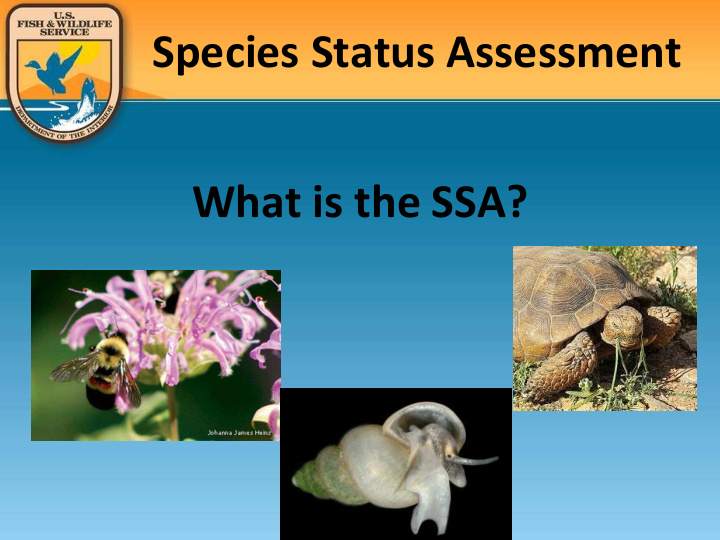



Species Status Assessment What is the SSA?
Species Status Assessment BIG PICTURE
Species Status Assessment Framework Benefits More rigorous species assessment • • A standardized analytical approach→ • Consistency from office to office & from decision to decision • Repeatable, transparent Science and Policy in proper context • • Provides efficiency, thus more effective conservation
SSA in ESA Processes Start Early! Species Assessment - ID data gaps - data collection Species Status Assessment Framework Project Decision Analysis Planning and Support Document - shows how information was Review and considered - timeliness of decision - roles and - use expertise Surname recommendations responsibilities - focuses discussion on major - can utilize Process issues - inclusive of all - timeliness tech. writer decision-makers - clarify - recognizes and explains - clarify - streamlined expectations uncertainty - achieves agreement expectations - reduce FR - timeliness early - standardizes status reviews - identify needs costs across program (listing, - document decisions recovery, and consultation) for the admin. record Who: Who: Who: Regional Office Field Office Ecological Services ARD Field Office Regional Office Ecological Services DARD State & Other Experts Field Office PL
SSA Framework • The SSA Framework is a different SPECIES NEEDS way of thinking about biological Current Availability status assessments under the ESA. or Condition of those Needs • Its purpose is to describe the SPECIES CURRENT CONDITION viability of species in a way that Future Availability or Condition of those supports our ESA decisions. Needs FUTURE SPECIES’ CONDITION SPECIES VIABILITY
Minimum Requirements All SSAs must include the following elements: 1) Life History – Description of species ecology, including requirements for reproduction and survival and ecological relationships between the species and its abiotic and biotic environment 2) Diagnosis – Description of the species’ current condition and hypothesized causal mechanisms that explain why it is in that condition. 3) Prognosis – A projection of the species’ future condition in response to future scenarios of threats, conservation actions, and changing environment, and an assessment of what that means in terms of risk to the species.
SSA Framework Viability is the ability of a species to sustain populations in the wild beyond a biologically meaningful time frame. • Viability is not a specific state; is or is not viable • Instead, viability is, at a specific point in time, the likelihood of/ability to sustain populations over time SSA Framework uses the principles of resiliency, representation, and redundancy to characterize a species’ viability at specific points in time.
SSA Framework Resiliency is the ability to withstand environmental stochasticity – Resiliency means to tolerate natural, annual variation in environment (dry/hot years vs wet/cold years) and recover from periodic disturbances (floods, occasional disease)
SSA Framework
SSA Framework Redundancy is the ability to withstand catastrophic events – Redundancy means that not all populations are exposed to catastrophic events concurrently, i.e., spreading the risk
SSA Framework
SSA Framework Representation is the adaptability or evolvability of the species; “adaptive capacity” or “evolutionary resiliency” – Representation is the ability to adapt to changing physical (climate, habitat) and biological (diseases, predators) conditions
SSA Framework
What is viability? • So, viability is the ability of the species to maintain multiple ( redundancy ), sustaining populations ( resiliency ) across the species’ ecological settings ( representation ) in order to withstand catastrophes ( redundancy ), environmental stochasticity ( resiliency ), and changes in environmental conditions ( representation ). Shafer and Stein describe viability simply as “saving some of everything” (REP) and “enough to last” (RES & RED)
Stages of the SSA Based on existing knowledge/data Forecasts Stage 1 Characterize Stage 3 Stage 2 species’ needs & ID Prediction of species’ Estimate of factors that future status given a species’ current influence those range of plausible status needs scenarios
Stage 3: Future Condition Scenarios depend on decision context – Listing • Stressors and conservation efforts – Recovery • Alternative recovery strategies – Consultation • Project vs no project • Project design options • Reasonable and prudent measures
Scalability
Working with Partners
Expert Involvement in the SSA Process ❖ Our objectives with respect to expert involvement in the SSA process are to: ▪ Elicit knowledge (information and judgment) from the most qualified experts with regard to the species’ current and future status ▪ Represent the diversity of expert judgment within the scientific community ▪ Facilitate open discussion and independent input in a cooperative manner ▪ Ensure timeliness and efficiency in conducting the assessment ▪ Safeguard the objectivity, neutrality, and scientific rigor of the assessment
Expert Involvement in the SSA Process ❖ Expert involvement may include the following: ❖ Participation from scientists who provide data, expert judgment, and analytical assistance on species biology, ecology, and/or environmental conditions that influenced viability at the population and species levels ❖ Degrees of involvement from individuals will vary based on expertise, need, and availability ❖ Expert participation may take place in a variety of forms, including group workshops, data delivery, webinars, individual meetings, and review of the SSA and its components at various stages of the process, including review of the final product (expert review is separate from peer review)
How to Start Early
SSA Resources NCTC Course Resources – Introduction to the Species Status Assessment https://nctc.fws.gov/courses/csp/csp3910/resources/ SSA Short Course https://sites.google.com/site/r4sdmssa/
Recommend
More recommend